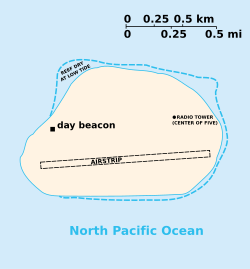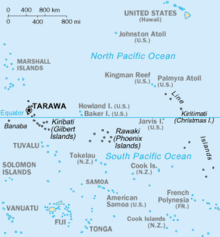m 1 revision from nost:Baker Island: import old edit, see User:Graham87/Import |
167.154.176.89 (talk) |
||
| Line 11: | Line 11: | ||
==Description== |
==Description== |
||
A cemetery and rubble from earlier settlements are located near the middle of the west coast, which is where the boat landing area is located. There are no ports or harbors, with anchorage available only offshore. The narrow fringing reef surrounding the island can be a maritime hazard, so there is a [[day beacon]] near the old village site. Baker's abandoned [[World War II]] runway, {{convert|1665|m|ft|abbr=on|lk=off}} long, is completely covered with vegetation and unusable. |
A cemetery and rubble from earlier settlements are located near the middle of the west coast, which is where the boat landing area is located. There are no ports or harbors, with anchorage available only offshore. The narrow fringing reef surrounding the island can be a maritime hazard, so there is a [[day beacon]] near the old village site. Baker's abandoned [[World War II]] runway, {{convert|1665|m|ft|abbr=on|lk=off}} long, is completely covered with vegetation and is unusable. |
||
The U.S. claims an [[Exclusive Economic Zone]] of {{convert|200|nmi|km|abbr=on|lk=off}} and [[territorial waters|territorial sea]] of {{convert|12|nmi|km|abbr=on|lk=off}} around Baker Island. |
The U.S. claims an [[Exclusive Economic Zone]] of {{convert|200|nmi|km|abbr=on|lk=off}} and [[territorial waters|territorial sea]] of {{convert|12|nmi|km|abbr=on|lk=off}} around Baker Island. |
||
Revision as of 21:24, 10 June 2010

Baker Island (Template:Pron-en) is an uninhabited atoll located just north of the equator in the central Pacific Ocean about 3,100 kilometers (1,700 nmi) southwest of Honolulu. The island lies almost halfway between Hawaii and Australia, and is a possession of the United States. Its nearest neighbor is Howland Island, 68 kilometers (37 nmi) to the north.
Baker is located at 0°11′41″N 176°28′46″W / 0.19472°N 176.47944°W.[1] It covers 1.64 square kilometers (410 acres), with 4.9 kilometers (3.0 mi) of coastline. The climate is equatorial, with little rainfall, constant wind, and strong sunshine. The terrain is low-lying and sandy: a coral island surrounded by a narrow fringing reef with a depressed central area devoid of any lagoon. Baker's highest point is 8 meters (26 feet) above sea level.
The island now forms the Baker Island National Wildlife Refuge, which consists of all 405 acres (1.64 km2) of the island and a surrounding 30,500 acres (123 km2) of submerged land. The National Wildlife Refuge is managed by the U.S. Fish and Wildlife Service as an insular area under the U.S. Department of the Interior. Baker Island is an unincorporated and unorganized territory of the U.S.
Its defense is the responsibility of the United States; though uninhabited, it is visited annually by the U.S. Fish and Wildlife Service. For statistical purposes, Baker is grouped with the United States Minor Outlying Islands.
Description
A cemetery and rubble from earlier settlements are located near the middle of the west coast, which is where the boat landing area is located. There are no ports or harbors, with anchorage available only offshore. The narrow fringing reef surrounding the island can be a maritime hazard, so there is a day beacon near the old village site. Baker's abandoned World War II runway, 1,665 m (5,463 ft) long, is completely covered with vegetation and is unusable.
The U.S. claims an Exclusive Economic Zone of 200 nmi (370 km) and territorial sea of 12 nmi (22 km) around Baker Island.
During a 1935–1942 colonization attempt, the island was most likely on Hawaii time, which was then 10.5 hours behind UTC.[2] Being uninhabited, the island's time zone is unspecified, but it lies in waters whose nautical time zone is 12 hours behind UTC.

History

Baker was discovered in 1818 by Captain Elisha Folger of the Nantucket whaling ship Equator, who called the island "New Nantucket". In August 1825 Baker was resighted by Captain Obed Starbuck of the Loper, also a Nantucket whaler. The name goes back to Michael Baker, who visited the island in 1834.[3] Other references state that he visited in 1832, and again on August 14, 1839, in the whaler Gideon Howland, to bury an American seaman.[4]
The United States took possession of the island in 1857, claiming it under the Guano Islands Act of 1856.[5] Its guano deposits were mined by the American Guano Company from 1859 to 1878. John T. Arundel and Company, a British firm, made the island its headquarters for its guano-digging operations in the Pacific from 1886 to 1891.
In the late 19th Century there were apparently some British claims on the island. To clarify American sovereignty, Executive Order 7358 was issued on May 13, 1936.[6]
In 1935, a short-lived attempt at colonization was begun.
The American colonists were landed from the USCGC Itasca, the same vessel that brought colonists to neighboring Howland Island, on April 3, 1935. They built a lighthouse, substantial dwellings, and attempted to grow various plants. One sad-looking clump of coconut palms was jokingly called "King-Doyle Park" after two well-known citizens of Hawaii, who visited on the Taney in 1938. This clump was the best on the island, planted near a water seep, but the dry climate and sea birds, eager for anything upon which to perch, did not give the trees or shrubs much of a chance to survive.[7]
King-Doyle Park was later adopted as a geographical name by the USGS.
The settlement was named Meyerton after Captain H.A. Meyer of the United States Army, who helped establish the camps for the colonists in 1935. It had a population of four American civilians, who were all evacuated in 1942 after Japanese air and naval attacks. During World War II it was occupied by the U.S. military.
Since the war, Baker Island has been uninhabited. Feral cats were eradicated from the island in 1964. Public entry is by special-use permit only from the U.S. Fish and Wildlife Service, and is generally restricted to scientists and educators.
Flora and fauna

Baker has no natural fresh water sources. It is treeless, with sparse vegetation consisting of four kinds of grass,[8] prostrate vines and low-growing shrubs. The island is primarily a nesting, roosting, and foraging habitat for seabirds, shorebirds, and marine wildlife.
Baker Island is home to a number of threatened and endangered species. The ruddy turnstone, bar-tailed godwit, sanderling, bristle-thighed curlew and Pacific golden plover are shorebirds that inhabit the island and are considered species of High Concern on the national conservation priority scheme. Green turtles and hawksbill turtles, both threatened, can be found along the reef.[9]
Seabird species such as the lesser frigatebird, brown noddy and sooty tern use the island for nesting and roosting. The island is also thought to be a rest stop for arctic-breeding shorebirds.
Image gallery
-
Baker Island coastline with red-footed booby
-
Fish and wildlife sign
-
Baker Island day beacon
-
Hermit crabs taking shade in day beacon
-
Settlement remains, radio tower in background
-
Masked booby on gravestone
-
Brown noddies with radio towers in background
-
Wreckage on Baker Island coast
See also
References
- ^ "Baker Island". Geographic Names Information System. United States Geological Survey, United States Department of the Interior. Retrieved 2009-02-24.
- ^ Elgen M. Long (2000). Amelia Earhart: the mystery solved. Simon & Schuster. p. 206.
Thursday, July 1, [1937] ... Howland Island was using the 10+30 hour time zone—the same as Hawaii standard time.
{{cite book}}: Unknown parameter|coauthor=ignored (|author=suggested) (help) - ^ Henry Evans Maude (1968). Of islands and men: studies in Pacific history. Oxford University Press.
- ^ Bryan, 1941
- ^ Edwin Horace Bryan (1941). American Polynesia: coral islands of the Central Pacific. Honolulu, Hawaii: Tongg Publishing Company.
- ^ [1] Memorandum of Secretary of State Cordell Hull to the president, February 18, 1936 Presidential Private File, Franklin D. Roosevelt Library, Hyde Park, N.Y. Retrieved: March 18, 2010
- ^ http://www.anytravels.com/oceania/baker
- ^ U.S. Dept. of Interior. Baker Island. Retrieved 6 July 2008.
- ^ http://www.fws.gov/bakerisland/
External links
- Baker Island National Wildlife Refuge
- Baker Island. This article incorporates material from The World Factbook 2000.





